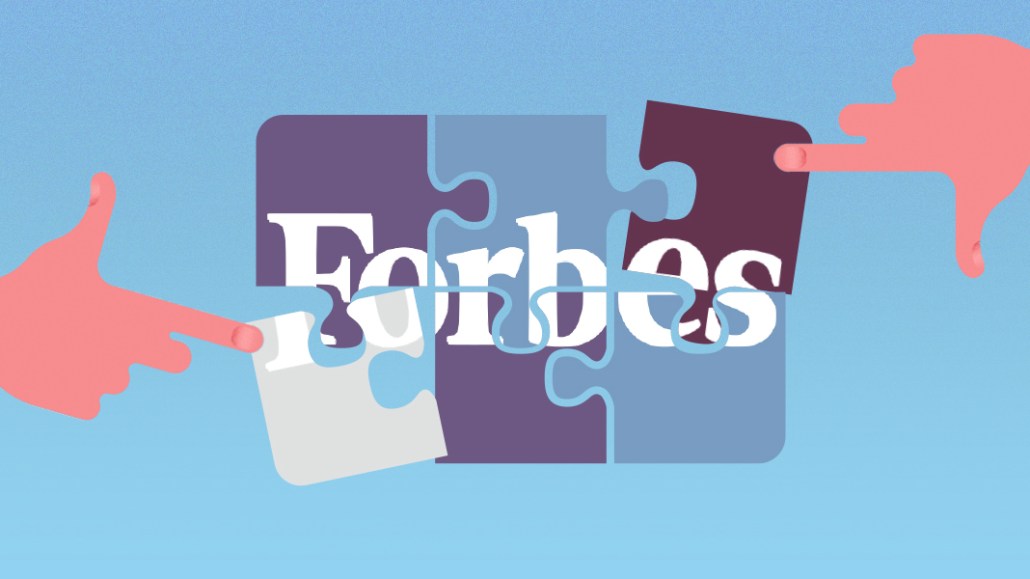Forbes Media acquires stock prediction tool to help diversify its revenues

At the beginning of 2019, Forbes Media had just finished celebrating its most profitable year in a decade and had begun hunting for companies it could invest in or buy. Nearly a year later, it has closed its first deal.
The company has acquired a majority stake in Quantalytics AI Labs, a service that uses artificial intelligence to predict the performance of different kinds of financial instruments, including stocks, exchange-traded funds and cryptocurrencies.
The terms of the deal were not announced, but SEC filings indicate that earlier this month Quantalytics sold $3.9 million worth of equity to four unnamed parties. The same filings indicate that Forbes Media’s chief financial officer, Michael York, and Forbes Media’s mergers and acquisitions lead, Taha Ahmed, were named as directors of Quantalytics. Two years earlier, Quantalytics had sold equity in its company for $2.65 million.
The acquisition, Forbes’ first since acquiring The Memo in 2018, is part of a recent focus on diversifying its revenue streams. Over the past five years, the percentage of annual revenue Forbes earns from non-advertising sources has doubled, from 18% in 2014 to more than one-third in 2019, a source close to the company said.
Much of that growth has been powered by Forbes’ events business and revenue generated from licensing, the source close to the company said. But more recently, Forbes has expanded into other areas.
It has experimented with bringing established offerings to market in new ways. In 2019, the company began offering its branded content platform — which includes both a studio as well as a distribution system — to advertisers in a software-as-a-service format, giving customers unlimited publication and distribution.
Forbes also has plans to further diversify revenue through franchises such as “30 Under 30,” which it is hoping to build into a kind of paid membership product.
The Quantalytics offering represents another avenue. Over the next year, Forbes will begin figuring out how to offer Quantalytics insights and information to its reporters, who will be free to use the information as they see fit. Forbes’ newsroom will have no obligation to incorporate the Quantalytics information into its output, said Matt Schifrin, Forbes’ vp and managing editor, but the expectation is that the data should present natural opportunities to offer more useful information to Forbes readers.
“I look at revenue diversification as the development of any non-advertising revenue, with advertising being the core product,” Forbes Media CEO Mike Federle said. “This, I look at a little differently. It will allow us to create new products that will create new revenue streams, but I look at it more as an application of technology on what has been one our core competencies, which is around investing.”
Forbes has been exploring ways to incorporate artificial intelligence into its product and operations. At the beginning of this year, a number of artificial intelligence features were added to its content management system, including an AI that recommends article topics to Forbes contributors.
“It’s exactly the kind of use of artificial intelligence that makes sense in a newsroom,” said John Wilpers, a senior director at Innovation Media Consulting. “Five years ago, 10 years ago, you would have had trouble convincing reporters to use it, what everybody saw AI as a threat to their jobs.
But now I think that it won’t be a struggle at all to convince the reporters to use this, because it will free them up to do the kinds of things only they can do.”
Eventually, Forbes will rebrand and repackage Quantalytics as a standalone subscription product, though the final product may look different. An earlier version of Quantalytics cost $100 for three months. It is not clear how much traction the company had. Quantalytics cofounder Stephen Mathai-Davis declined to answer questions about how many customers the business had amassed before Forbes acquired it.
More in Media

Digiday+ Research: Publishers’ growing focus on video doesn’t translate to social platforms
Major publishers have made recent investments in vertical video, but that shift is not carrying over to social media platforms.

Technology x humanity: A conversation with Dayforce’s Amy Capellanti-Wolf
Capellanti-Wolf shared insight on everything from navigating AI adoption and combating burnout to rethinking talent strategies.

How The Arena Group is rewriting its commercial playbook for the zero-click era
The company is testing AI-powered content recommendation models to keep readers moving through its network of sites and, in doing so, bump up revenue per session – its core performance metric.








